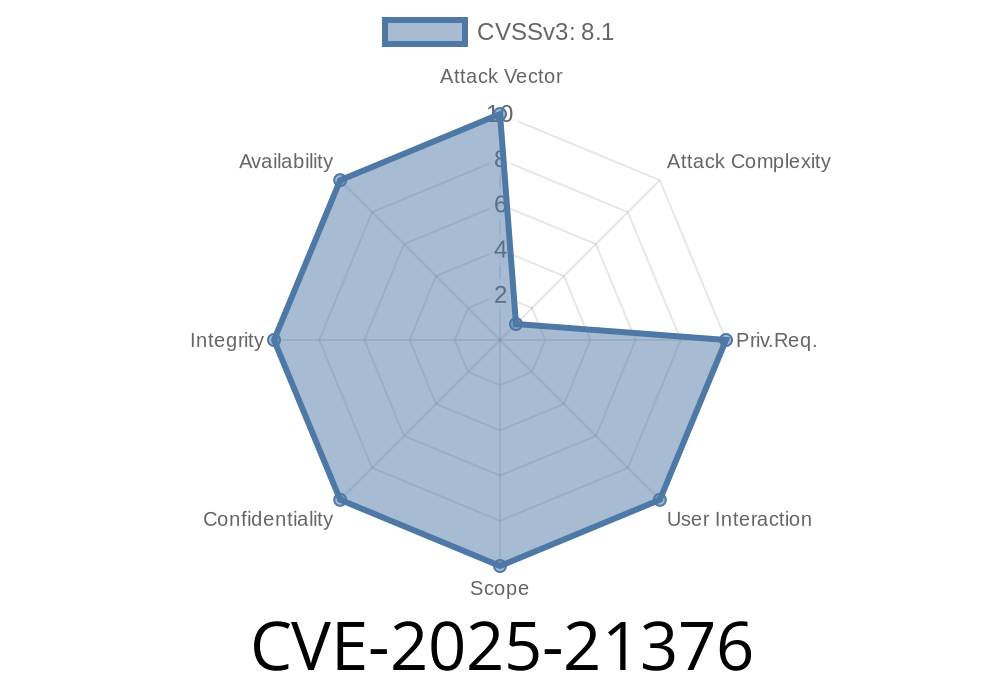As more businesses operate online and rely on complex networks to manage their systems, cybersecurity is increasingly becoming a top priority. Today, we're taking a closer look at a critical vulnerability in the Windows Lightweight Directory Access Protocol (LDAP) system, specifically with the CVE-2025-21376 identifier. In this post, we'll discuss the details of the vulnerability, provide sample code illustrating the issue, and offer guidance on how to mitigate it.
What is Lightweight Directory Access Protocol (LDAP)?
LDAP is an open standard application protocol used for accessing and managing distributed directory services, such as those provided by Microsoft's Active Directory (AD). The primary function of LDAP is to provide a means for connecting, searching, and updating various types of information stored in a directory service. Essential to many organizations, LDAP allows for authentication, authorization, and the organization of user accounts and other objects.
The Vulnerability: CVE-2025-21376
CVE-2025-21376 outlines a remote code execution vulnerability in Windows LDAP. A remote attacker exploiting this vulnerability could potentially execute code on the target system with elevated privileges, thereby compromising the security and integrity of the entire system. The crux of this vulnerability lies in the mishandling of specially crafted LDAP requests by the Windows LDAP client, leading to a buffer overflow issue.
Exploit Details
To exploit this vulnerability, an attacker must initiate a series of specially crafted LDAP requests—a detailed process that involves the following steps and code snippets:
Identify the target system's LDAP server to craft a malicious LDAP request.
import ldap
ldap_server = 'ldaps://ldap.example.com'
ldap_conn = ldap.initialize(ldap_server)
2. Use the simple_bind_s() method to perform a lightweight authentication. In this case, the username and an empty password allow the program to proceed with the attack.
username = "cn=admin,dc=example,dc=com"
password = ""
try:
ldap_conn.simple_bind_s(username, password)
except ldap.LDAPError as e:
print("LDAP error: ", e)
Forge a malicious LDAP request
base_dn = 'dc=example,dc=com'
search_scope = ldap.SCOPE_SUBTREE
search_filter = '(&(objectclass=*))' # This filter would target all objects in the directory service.
# Craft a malicious LDAP request using the search_ext() method:
try:
ldap_req = ldap_conn.search_ext(base_dn, search_scope, search_filter)
except ldap.LDAPError as e:
print("LDAP search error: ", e)
Process the malicious LDAP request to exploit the vulnerability and execute remote code.
try:
while True:
result_id, data = ldap_conn.result(ldap_req, all=)
if data == []:
break
if result_id:
# Execute malicious code here
pass
except ldap.LDAPError as e:
print("LDAP result error: ", e)
Original References and Additional Resources
- Microsoft Security Guidance for LDAP
- NIST's National Vulnerability Database (NVD) Entry for CVE-2025-21376
- Python-ldap Library Documentation
Mitigation Strategies
In order to protect your organization from the CVE-2025-21376 vulnerability, implement the following recommendations:
1. Update your Windows LDAP systems to the latest version, as Microsoft may have released patches addressing this vulnerability.
Use secure LDAP (LDAPS) instead of using LDAP over unencrypted connections.
3. Implement proper access controls and authentication methods to limit the potential attack surface for LDAP servers.
4. Regularly audit and monitor LDAP servers for abnormal patterns and behaviors that could signify an exploit attempt.
Conclusion
The CVE-2025-21376 vulnerability in Windows LDAP is a critical flaw that has potentially disastrous consequences. Understanding the exploit process and implementing robust security measures is crucial to securing your organization's systems. Stay vigilant, keep systems updated, and stay informed about emerging cybersecurity threats.
Timeline
Published on: 02/11/2025 18:15:36 UTC
Last modified on: 03/12/2025 01:42:12 UTC
